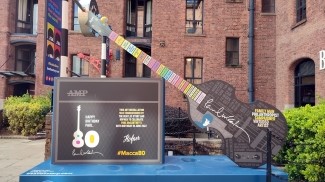This webpage begins with a brief introduction to the city, followed by photos and descriptions of some of the main sites seen during a walk around the city. The walk begins at St George’s Hall (fairly close to the Liverpool Central Travelodge, where the webpage author stayed), heading in an approximate clockwise direction around the city centre, taking in the Metropolitan Cathedral and Liverpool, Cathedral, heading down the famous River Mersey and following the riverbank, before turning inland, ending up in the very heart of the city. For convenience, there is a clickable index of the main sites seen at the end of the webpage Here.
Furthermore, as well as this webpage, there are three related webpages for the reader, looking at The Beatles in Liverpool, Crosby Beach, and Frank Hornby (click on each to view). The Beatles in Liverpool webpage includes a look inside the famous (New) Cavern Club.
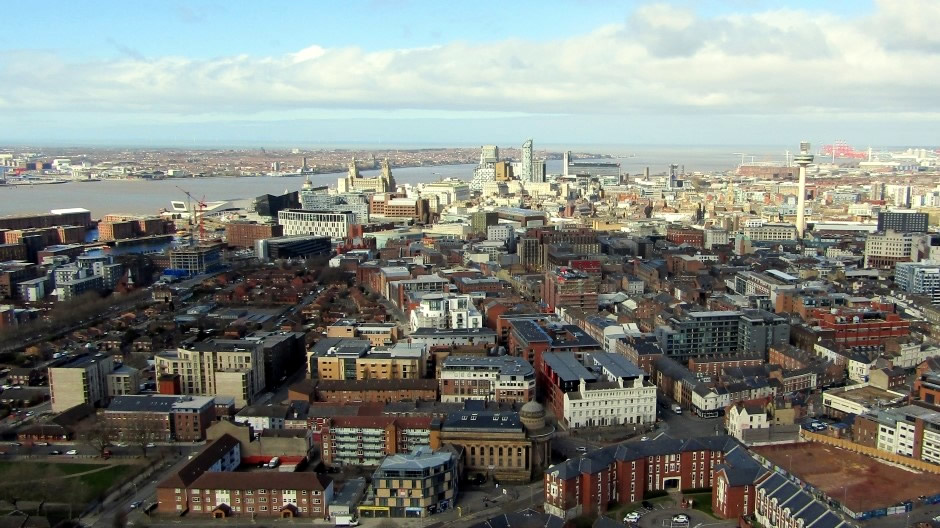
A Brief Introduction to Liverpool
Liverpool is a city and metropolitan borough in North West England. It is famous for its rich cultural heritage, maritime history and musical legacy. With a population of approximately half a million, it is the sixth-largest city in the UK. Liverpool is located within the county of Merseyside and is the principal city of the wider Liverpool City Region; its metropolitan area is the fifth largest in the United Kingdom, with a population of 2.24 million (City: 500,500). It is one of the most visited cities in the country, attracting millions of tourists every year.
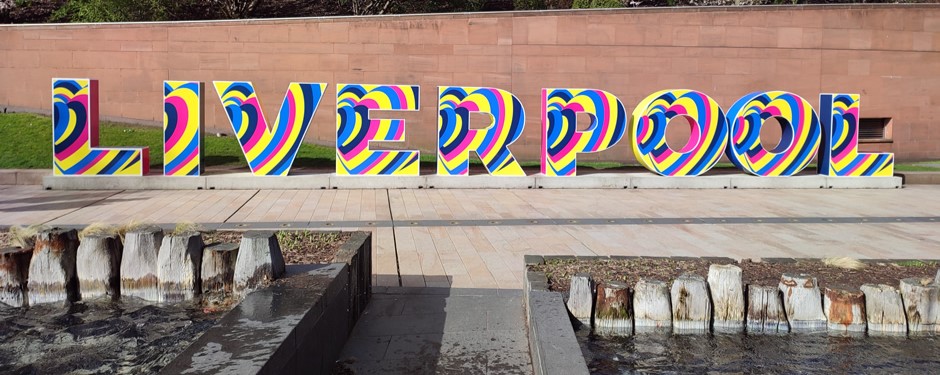
The history of Liverpool can be traced back to 1190 when the place was known as ‘Liuerpul’, possibly meaning a pool or creek with muddy water, although other origins of the name have been suggested. The borough was founded by royal charter in 1207 by King John, at a time when it was made up of only seven streets in the shape of the letter “H”. Liverpool was officially founded as a port town in the 13th century, and it grew rapidly during the Industrial Revolution and ignominiously as a result of the transatlantic slave trade. Liverpool was a major hub for trade, commerce and innovation, and in the 19th century it became one of the wealthiest and most influential cities in the world (evidence can be seen today in much of the city’s glorious historical architecture). During this time, the city had the largest and most advanced port in the world which made it the first city to have trade connections with all corners of the globe; the population had grown to around 77,000 in 1801 but this increased dramatically by 1851 to a staggering 376,000. Liverpool was also the home of many social movements and reforms, such as the abolition of slavery, the creation of trade unionism and women's suffrage.
Liverpool is best known for its musical heritage, especially as the birthplace of The Beatles, the most successful band in history. Liverpool has produced many other famous musicians and bands, such as Cilla Black, Gerry and the Pacemakers, Echo and the Bunnymen, Frankie Goes to Hollywood and The Zutons. Liverpool is also a UNESCO City of Music, and hosts many festivals and events throughout the year. In 2023, it hosted the Eurovision Song Contest (Ukraine won the 2022 competition and the UK came in second place, although the former were unable to host the competition due to the ongoing war with invading Russian forces).
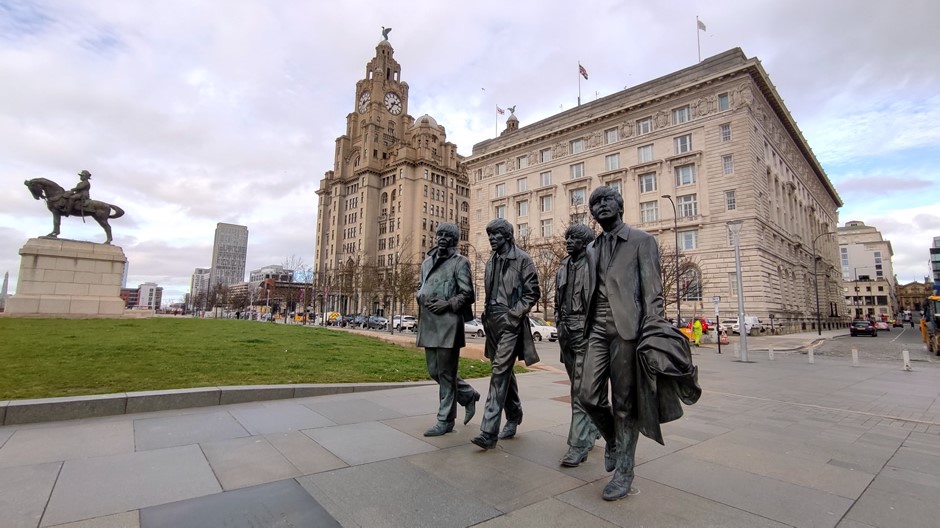
Liverpool is also a city of culture and art, with more museums and galleries than any other UK city outside London. Some of the most popular attractions include the World Museum, the Tate Liverpool, the Walker Art Gallery and The Beatles Story. Liverpool was also a UNESCO World Heritage Site, because of its many historic buildings and landmarks, such as the Albert Dock, the Liver Building and the St George's Hall. Unfortunately, this status was removed when UNESCO concluded that years of development had led to an “irreversible loss” to the historical value of its Victorian docks - perhaps a small price to pay in creating a city that today is more liveable than it ever has been before, post industrial decline.
Liverpool is a vibrant and diverse city, with a friendly and welcoming atmosphere. The city has a strong sense of identity and pride, and is known for its distinctive accent and humour. Liverpool is also a city of sport, with two famous football clubs, Liverpool FC and Everton FC, as well as many other sporting venues and events. Liverpool is a city that has something for everyone, whether the visitor is interested in history, culture, music or entertainment. Liverpool is a city that will surprise, delight and inspire, and one that the visitor will never forget.
A Selection of the City’s Main Sights
Below are shown some of the city’s main points of interest. This selection is by no means exhaustive and reflects those seen and/or visited during a 3-night stay in the city centre. This includes a full-day’s walk (described at the start of this webpage). Free or inexpensive tourist maps are readily available (as well as numerous guide books) which can help the visitor plan or follow a suggested route around the city to suit interests and time available. For those who prefer not to walk, bus tours of the city (including hop-on-hop-off services) are available. Please note that some opening times have been included but these may be subject to change and the author of this page accepts no responsibility for any errors or such changes, so best to check with the appropriate place first, if intending to visit.
 |
 |
St George’s Hall (above) is a building on St George’s Place, opposite Lime Street railway station in the city centre. Opened in 1854, it is a neoclassical building which contains concert halls and law courts. It is recorded in the National Heritage List for England as a designated Grade I listed building. The hall has been used for many purposes over the years including concerts, exhibitions, and civic events. It is also used as a venue for weddings.

The World Museum (above) is a large museum which has extensive collections covering archaeology, ethnology and the natural and physical sciences. It is located on William Brown Street in the city centre. The museum has a planetarium and a natural history centre. The exhibitions include incredible objects from around the world. As of the time of writing, the museum is open Tuesday to Sunday and bank holidays from 10am to 5pm and general admission is free.

The Grade II listed Picton Reading Room, part of the Liverpool Central Library
Liverpool Central Library is the largest of the 22 libraries in Liverpool and is situated in the heart of the city. It is a beautifully re-modelled building with Wi-Fi access throughout. At the time of writing, the library is open on Monday to Friday from 9:00am to 8:00pm, on Saturday from 9:00am to 5:00pm and on Sunday from 10:00am to 5:00pm. The library has won multiple awards for its architecture and services.

The Walker Art Gallery (above) houses one of the largest art collections in England outside London. It is part of the National Museums Liverpool group. The gallery, located on William Brown Street, has a collection of beautiful paintings, sculptures and decorative art from the 13th century to the present day. It has one of the most important painting collections in the country, including European Renaissance, Pre-Raphaelite, and Impressionist works. Masterpieces by Rubens, Rembrandt, Turner and Rossetti can all be viewed within its galleries, whilst contemporary artists with works on display here include pieces by David Hockney, Rose Wylie and others. At the time of writing, the Walker Art Gallery is open Tuesday to Sunday and bank holidays from 10am to 5pm.

County Sessions House (above) is a former courthouse that was constructed between 1882 and 1884 in the neoclassical style. It is located next to the Walker Art Gallery, which now uses it. The County Sessions House is a Grade II listed building. The County Sessions House is a reminder of Liverpool's judicial past and a fine example of Victorian architecture. The building was designed by Francis and George Holme, local architects who also worked on the Liverpool Cotton Exchange and the Royal Insurance Building. Inspired by Renaissance Venice, it features a grand portico with eight pairs of Corinthian columns, a frieze with the inscription "COUNTY SESSIONS HOUSE", and a tympanum with the arms of Lancashire County Council (a reminder of the pre-Merseyside days). The building is made of ashlar stone on a granite base, with some parts in yellow brick and stone. Inside can be found an Italian Renaissance staircase, the two court rooms, the Grand Jury Room, barristers' chambers, judge's chambers, cells, and administrative facilities. The building served as a courthouse until 1984, when the Crown Courts moved to Derby Square. It then became the Merseyside Museum of Labour History in 1986, but this closed in 1991. Since then, the building has been used by the Walker Art Gallery for staff and storage purposes.

The Wellington Memorial Statue is located on the corner of William Brown Street and Lime Street. It is also known as Wellington’s Column or the Waterloo Memorial. The monument is a Grade II listed building and is a monument to the Duke of Wellington. It was designed by Matthew Cotes Wyatt and was completed in 1865. Like Nelson’s Column in London, the statue stands on top of a column.

The Empire Theatre in Liverpool (above) is located on the corner of Lime Street and London Road. It has the largest two-tier auditorium in Britain and can seat 2,348 people. The theatre hosts a wide range of entertainment including variety shows, musicals, operas, pop concerts, and plays. The theatre opened its doors in 1925 on the site of the former New Prince of Wales Theatre and Opera House (later The Empire). Tickets for events can be purchased online, through their booking line, or in person at their box office.

The Royal Court Theatre (above) is located at 1 Roe Street and the current building was opened on 17 October 1938, after fire destroyed its predecessor. It was rebuilt in Art Deco style and soon became Liverpool’s premier theatre. The interior of the building has a nautical theme, in line with Liverpool’s seafaring traditions. The Royal Court Theatre is a Grade II listed building and is considered one of the best theatres built in the Art Deco style. Tickets can be purchased online or in person at their box office.

Liverpool Lime Street is a terminus railway station and the main station serving the city centre of Liverpool. It opened in 1836 and is the oldest still-operating grand terminus mainline station in the world. It is also Liverpool’s largest and most popular train station. During 2017, work commenced at Lime Street station on a £340 million remodelling programme. The station has a range of facilities including shops, cafes, and parking.

Just inside the main entrance, on the station’s main concourse, is a bronze statue of legendary Merseyside comedian Ken Dodd (above). The statue, called “Chance Meeting”, was unveiled on June 11, 2009, and shows the entertainer (shown here on the left) greeting the late Merseyside Labour MP Bessie Braddock. The statue was commissioned by Merseytravel and designed by Liverpool-based artist Tom Murphy. For any readers unfamiliar with British culture and entertainment, Sir Kenneth Arthur Dodd OBE (1927-2018) was an English comedian, singer and occasional actor. He was described as “the last great music hall entertainer”, and was primarily known for his live stand-up performances. A lifelong resident of Knotty Ash in Liverpool, Dodd’s career as an entertainer started in the mid-1950s right up until just a few months before he died.

The Adelphi Hotel (above) was built in 1826 and has original period features including chandeliers and marble halls. It is a fabulous Edwardian style building and has a rich history. Famous guests to have stayed here include Winston Churchill, Franklin D. Roosevelt, Frank Sinatra, Laurel and Hardy, Judy Garland and Bob Dylan. The Beatles also stayed here when playing back in Liverpool during their early tours. Today, the Adelphi Hotel serves as the Hub for International Beatleweek.

The Lewis’s Building (above) is a 20th-century Grade II listed building on Lime Street In 1856 men's and boy's clothing store Lewis's began trading from 19th century building on the current site. This building was eventually replaced in the 1910s and 1920s with a design by Gerald de Courcy Fraser and incorporated the adjacent Watson Building. The site was regarded as the flagship store of the now defunct Lewis’s department store chain. At the time of writing, the building is set to be redeveloped as part of Central Village (a large shopping, leisure, commercial and residential complex).

The University of Liverpool (above) is a public research university. It was founded as a college in 1881 and gained its Royal Charter in 1903 with the ability to award degrees. It is one of the country’s six “red brick” civic universities, and is also a Russell Group university. The university’s Victoria Building was the inspiration for the term "red brick university", making it the first such university, and in 2008, this particular building was converted into the Victoria Gallery & Museum. The art gallery and museum is run by the University of Liverpool and is open to visitors (Tue-Sun, 10am-5pm, at the time of writing); it also includes a café and gift shop.

Liverpool Metropolitan Cathedral (above) is an impressive building that stands as the mother church of the Roman Catholic Archdiocese of Liverpool. It was designed by Sir Frederick Gibberd, who won a worldwide competition for the project in 1960. The cathedral was completed in 1967 and has a distinctive circular shape and a conical roof. With a height of 331 feet (101m) it is also one of the world's tallest non-spired church buildings. The cathedral is also known as the Metropolitan Cathedral of Christ the King, reflecting its dedication to the kingship of Jesus Christ. It is one of Liverpool's many listed buildings and a major landmark of the city. The cathedral has a rich history and heritage that dates back to the 19th century, when the Catholic population of Liverpool increased dramatically due to the Irish famine. The first attempt to build a cathedral was made by Edward Welby Pugin, who completed the Lady Chapel in 1856, but the project was abandoned due to lack of funds. The second attempt was made by Sir Edwin Lutyens, who designed a massive structure that would have been the second-largest church in the world, but only the crypt was built before World War II halted the work. The third and final attempt was made by Gibberd, who created a modern and innovative design that contrasted with the Gothic style of the Anglican cathedral at the other end of Hope Street. The cathedral is a place of worship, music, art and learning. It hosts regular services and liturgies, as well as concerts, events and conferences. It has a magnificent organ, a treasury of sacred objects and relics, and a collection of modern stained glass windows that create a colourful and luminous atmosphere. The cathedral also has a Lutyens crypt and a visitor centre that offer guided tours and exhibitions. The cathedral is open to visitors every day and welcomes people of all faiths and backgrounds. Some more photos of the cathedral, including its interior, can be seen in the thumbnail gallery below (click on an image to enlarge):

The Philharmonic Dining Rooms (above) is a public house located at the corner of Hope Street and Hardman Street. It is commonly known as “The Phil” and is diagonally opposite the Liverpool Philharmonic Hall. The pub was built between 1898 and 1900 and designed by the local architect Walter W. Thomas. It is recorded in the National Heritage List for England as a designated Grade I listed building. The pub is built in the style of a gentleman’s club and has wood panelling, rich tiling, leather sofas, stained glass and chandeliers. The Beatles used to drink here in their early years; John Lennon was a regular and once famously said “The Philharmonic is one of the few pubs you can go into where you can’t hear a jukebox or a fruit machine. It’s like walking into a church; it’s got that atmosphere”.

The Liverpool Philharmonic building (above) is a concert hall located in Hope Street. It is the home of the Royal Liverpool Philharmonic Society and is recorded in the National Heritage List for England as a designated Grade II listed building. The building was designed by leading Liverpool architect Herbert Rowse in an Art Deco style and was strongly influenced by the contemporary work of the celebrated Dutch architect Willem Marinus Dudok. The hall stages over 60 classical music concerts and in total, around 250 events each year.

A Case History (above) is a sculpture by John King that was installed on Hope Street in 1998. It consists of several stone suitcases, trunks and guitar cases that are stacked on the pavement. Each piece of luggage has the name of a famous person who has a connection to Liverpool, such as John Lennon, Ken Dodd and Bessie Braddock. The sculpture represents the history of migration and travel through the city, as well as its cultural and artistic heritage.

The Liverpool Institute for Performing Arts (LIPA) is a world-renowned university-level creative and performing arts training provider with a portfolio of ambitious and popular courses. LIPA was co-founded by Sir Paul McCartney and Mark Featherstone-Witty to provide the best teaching and learning for people who want to pursue a lasting career in the arts and entertainment industry, whether as performers or those who make performance possible. The institute was opened by Queen Elizabeth II on 7 June 1996 and was designated as a higher education institution (HEI) in 2006. LIPA purchased the former building of the Liverpool College of Art for £3.7 million in March 2012 to expand its teaching accommodation. Building work started on the Art School in 2014 and was completed in August 2016.

Liverpool Cathedral is the largest cathedral in the UK and the fifth largest in the world. It is located on St James's Mount and was built between 1904 and 1978. The cathedral is dedicated to Christ and the Blessed Virgin Mary, and is the seat of the Bishop of Liverpool. The cathedral has a rich history and a stunning architecture that attracts millions of visitors every year. Some of the highlights of the cathedral include:
● The Great West Window, which is the largest stained glass window in
Britain and depicts scenes from the Bible and Liverpool's history
● The Lady Chapel, which is the oldest part of the cathedral and
contains a beautiful marble altar and a mosaic ceiling
● The Well, which is a circular space under the tower symbolising the
source of life and features a sculpture of water flowing from a rock
● The Tower, which is the highest and heaviest cathedral tower in the
world, offering panoramic views of the city and beyond
● The Tracey Emin artwork, which is a neon sign that reads "I felt you
and I knew you loved me" and is installed inside above the west door
Liverpool Cathedral is more than just a place of worship - it is also a venue for concerts, exhibitions, events, and education. It hosts the annual Liverpool Passion play, which re-enacts the last days of Jesus Christ. It also offers guided tours, workshops, lectures, and activities for children and adults. Liverpool Cathedral is open to everyone, regardless of faith or background. It is a place of inspiration, beauty, and peace. If you are visiting Liverpool, you should not miss this magnificent landmark. Some more photos of the cathedral, including its interior as well as views from the tower, can be seen in the thumbnail gallery below (click on an image to enlarge):

St Luke's Bombed-Out Church is a former Anglican parish church. The church was designed by John Foster, a prominent Liverpool architect who also worked on the Royal Liverpool Infirmary and the Liverpool Customs House. It was consecrated in 1831 and served as a parish church until 1941. It had a capacity of 1,500 people and a 150-foot spire that dominated the city skyline. On 6 May 1941, during the Liverpool Blitz, the church was hit by a World War II German incendiary device. The fire destroyed the roof and the interior of the church, leaving only the walls and the tower standing. The church was never rebuilt after the war, but it was preserved as a reminder of the civilian casualties of the war. Today, as well as functioning as a living war memorial, it is a creative community hub. It is open to visitors and hosts a variety of events, including art exhibitions, concerts, festivals, markets, yoga classes and more. The church is also a popular tourist attraction and a symbol of Liverpool's resilience and creativity and is of particular interest, as it is one of the few surviving examples of a World War II bombed-out church in Europe. It has been featured in several films and TV shows, such as Peaky Blinders, Harry Potter and the Deathly Hallows Part 1, and Captain America: The First Avenger.

Liverpool Chinatown is an area of Liverpool that is an ethnic enclave home to the oldest Chinese community in Europe. It is located in the south of the city centre and has many Chinese businesses such as Chinese restaurants and supermarkets, and facilities for the Chinese community. Liverpool’s Chinatown was the first to be established in Europe. In the late 1860’s many Chinese migrants first arrived in Liverpool as a result of employment of Chinese seamen by the Blue Funnel Shipping Line, creating strong links between the cities, Shanghai, Hong Kong and Liverpool.
For All Liverpool's Liver Birds (Wings)

For All Liverpool’s Liver Birds (Wings) is a street art and large mural created by Liverpool artist Paul Curtis. It is also known as The Liver Bird Wings. The mural pays tribute to Liverpudlians with the words “For all Liverpool’s Liver Birds” and features a pair of wings that allow people to transform themselves into an iconic Liver Bird. The artwork has become very popular and has attracted a string of famous people and local athletes to pose in front of it for pictures.
Arena and Convention Centre (ACC) Liverpool
ACC Liverpool is a conference and exhibition centre located on the waterfront in Liverpool City Centre. It is part of Liverpool's event campus, consisting of an interconnected arena, a convention centre, and an exhibition centre:

The M&S Bank Arena (above) is an entertainment venue and part of the ACC Liverpool Group and opened in 2008. The arena has a capacity of 11,000 and has hosted many events such as concerts, comedy shows and sporting events. Performers to have played here include Ariana Grande, Katy Perry, Ed Sheeran, Elton John, and Celine Dion. Some of the big events that have taken place at M&S Bank Arena include the MTV Europe Music Awards in 2008, the MOBO Awards in 2010, the BBC Sports Personality of the Year in 2017, and the Eurovision Song Contest 2023.

The BT Convention Centre (above) is a modern and versatile venue that offers a range of spaces for events of all sizes, from conferences and exhibitions to concerts and banquets. The centre is part of the ACC Liverpool complex and features a large auditorium, 18 breakout rooms and an approx. 40,000 square foot (3,725m²) hall. The centre is easily accessible by public transport and has ample parking facilities. It has hosted more than 200 events, including the British Council of Shopping Centres Annual Conference and the Labour Party Conference.

Exhibition Centre Liverpool (above) is a multi-million pound purpose-built exhibition centre located on the waterfront in the city centre. It is part of the ACC Liverpool Group and opened in 2015, making it the latest addition to Liverpool event campus. The centre has three halls, an atrium, and a glazed entrance overlooking the River Mersey. It has hosted many events such as conferences, trade shows, and exhibitions.

The Wheel of Liverpool (above) is a transportable Ferris wheel installation on the Keel Wharf waterfront of the River Mersey. It was originally opened on 25 March 2010 and is near to the M&S Bank Arena. The wheel was dismantled for refurbishment in the Netherlands in November 2020 and rebuilt in spring 2021. A visit to the Wheel of Liverpool offers riders stunning panoramic views of the city’s famous landmarks and includes fascinating commentary whilst sitting and enjoying the city from a unique perspective.

Above: The Royal Albert Dock as Seen from the Museum of Liverpool
The Royal Albert Dock is a complex of dock buildings and warehouses near the city centre. It was designed by Jesse Hartley and Philip Hardwick and opened in 1846. The dock was named after Prince Albert, who laid the foundation stone in 1841. The dock was the first in the world to be built entirely of cast iron, brick and stone, with no structural wood. It was also the first to use hydraulic cranes. The dock was closed to shipping in 1972 due to its inability to accommodate modern cargo ships. Having sat derelict for nearly a decade, redevelopment of the dock began in 1981, when the Merseyside Development Corporation was set up. The Albert Dock was restored and redeveloped as a tourist attraction and cultural centre, officially re-opening in 1984. Today, it is a major tourist attraction in the city and has been described as the most visited multi-use attraction in the United Kingdom outside London. The docking complex and warehouses also comprise the largest single collection of Grade I listed buildings anywhere in the UK. The Royal Albert Dock in Liverpool is home to popular attractions including the International Slavery Museum, The Beatles Story, Tate Liverpool, and the Merseyside Maritime Museum, (the latter 3 being detailed below). Visitors can also take advantage of the impressive array of retail and leisure outlets on offer here.

The Beatles Story is a museum about the Beatles and their history, and as mentioned above, is located on the historical Royal Albert Dock. The museum takes visitors on an immersive journey through the lives, times, culture and music of the world’s greatest band. Liverpool is famously known as the hometown of the Fab Four.
Note: For more information on the Beatles in Liverpool (including the Cavern Club, Penny Lane, and Strawberry Fields to name a few places), please visit the separate webpage Here (internal link).
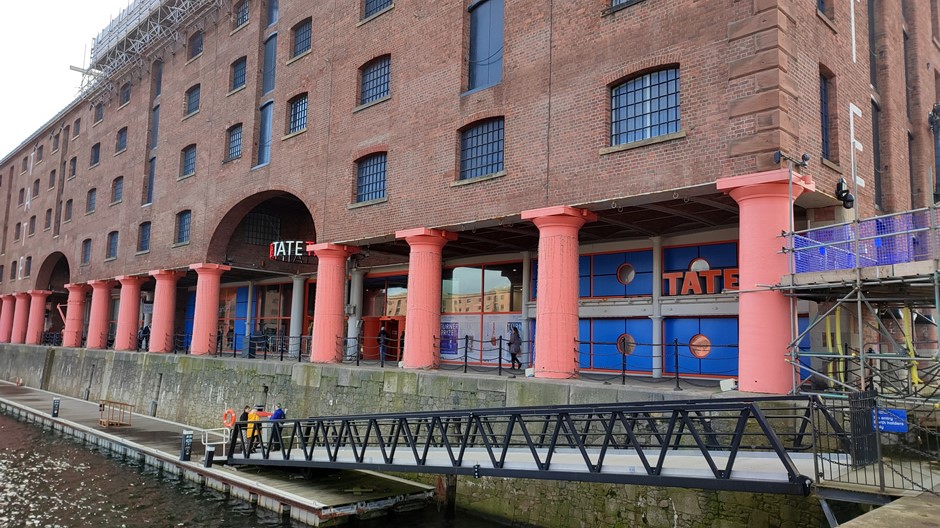
Tate Liverpool is an art gallery and museum located in the Albert Dock complex and is part of Tate, along with Tate St Ives, Cornwall, Tate Britain, London, and Tate Modern, London. The gallery has a collection of British and international modern and contemporary art. At the time of writing, it is open from Monday to Sunday from 10am to 5:50pm.
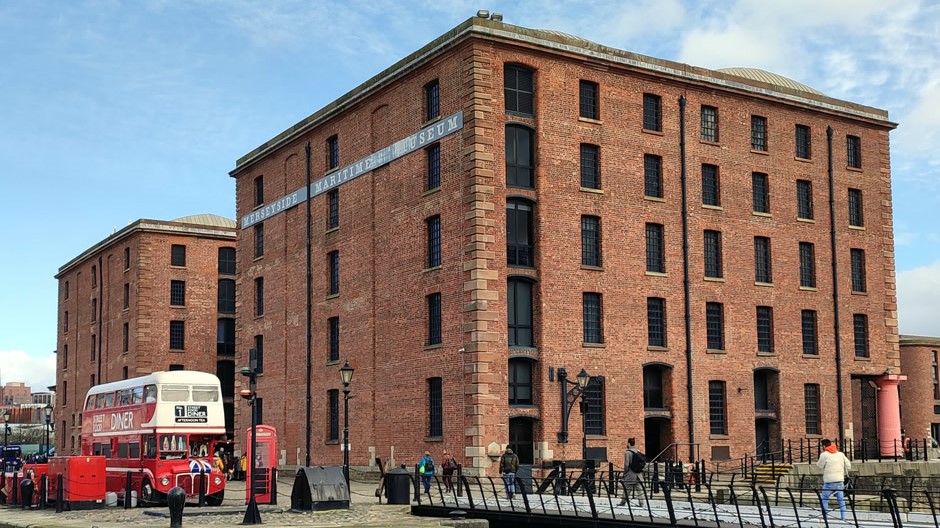
The Merseyside Maritime Museum is a great place to visit for anyone interested in the history of Liverpool and its role in the maritime trade. As mentioned above, it is located in The Royal Albert Dock. The museum showcases the rich heritage of this port city, from its involvement in the slave trade and the Titanic disaster, to its role in World War II and modern-day shipping. Various exhibits, galleries and collections tell the stories of the people, ships and events that shaped Liverpool's maritime history. The museum also offers guided tours, workshops and special events throughout the year.

Moving northwards along the waterfront from The Royal Albert Dock and in front of the Pier Master’s House, there is a bronze statue of Billy Fury. Billy Fury was an English musician and actor. He was born Ronald Wycherley in Liverpool in 1940 and by the time he was 20, he had his first UK top ten hit with his own composition, Colette. As Billy Fury, he spent an impressive 332 weeks on the charts during the 1960’s, and matched the Beatles’ record of 24 hit singles. Although his management and commercial pressures led him to become known to the public as a balladeer, Billy Fury was Britain’s number 1 rock and roller. The statue was funded primarily from fans and was unveiled in 2003. It was made by Liverpool sculptor Tom Murphy and was commissioned by “The Sound of Fury” fan club, following six years of fundraising and donations from fans, both members and non-members, from home and abroad. The statue is located adjacent to the river Mersey and recalls Fury’s time working as a deck hand on the Mersey River tugboat, The Formby.
The Museum of Liverpool is the world’s first national museum devoted to the history of a regional city and the largest newly-built national museum in Britain for more than a century. It is located on Liverpool’s famous waterfront in a striking modern building that reflects Liverpool’s history as a great port city. The museum tells the story of Liverpool and its people, from its geological origins to the present day. It explores the city’s unique geography, history, and culture, as well as its place in the wider world.

Above: The Museum of Liverpool
The museum opened in 2011 and showcases the history and culture of Liverpool and its people within its four main galleries: The Great Port, Global City, People's Republic and Wondrous Place. The museum also hosts temporary exhibitions and events throughout the year that reflect the diversity and creativity of the city; each of the four gallery themes explore a different aspect of Liverpool's identity and heritage, from its maritime and industrial past to its musical and artistic legacy. Some of the highlights of the museum include a life-size replica of the Liverpool Overhead Railway, a collection of objects related to the Beatles, a giant Liver Bird sculpture and a panoramic view of the waterfront. The Museum of Liverpool has won several awards for its architecture and exhibitions and is a must-see for anyone who wants to learn more about this vibrant and fascinating city. Some photos taken from a visit to the museum can be seen in the thumbnail gallery below (click on an image to enlarge):

“The Three Graces” is a term used to describe the three buildings (above) that form the traditional Liverpool waterfront skyline; they are the Royal Liver Building, the Cunard Building, and the Port of Liverpool Building. The Three Graces are located at Pier Head on the banks of the Mersey. These majestic buildings were conceived and constructed as visible symbols of Liverpool’s international prestige - proud emblems of its commercial prowess. More on each of The Three Graces follows:

The Royal Liver Building (above) is a Grade I listed building that opened in 1911 as the headquarters to the Royal Liver Group. It holds a significant historical and cultural importance to the city and is also one of the most recognizable landmarks in Liverpool, with its two fabled Liver Birds which watch over the city and the sea. Legend has it that if these two birds were to fly away, the city would cease to exist. To get a sense of scale, the Liver Birds are 18 feet (5½m) high.
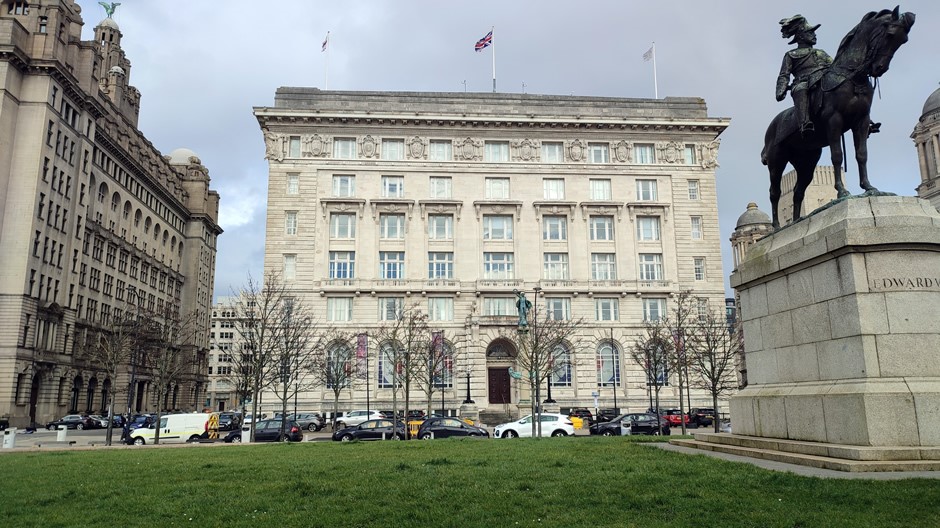
The Cunard Building (above) is a Grade II listed building and was originally built as the headquarters of the Cunard Steamship Company (Cunard Line shipping company). The building was completed in 1917 and was designed by William Edward Willink and Philip Coldwell Thicknesse. It was used as Cunard’s headquarters until the 1960’s and today is used as office space.
The Port of Liverpool Building
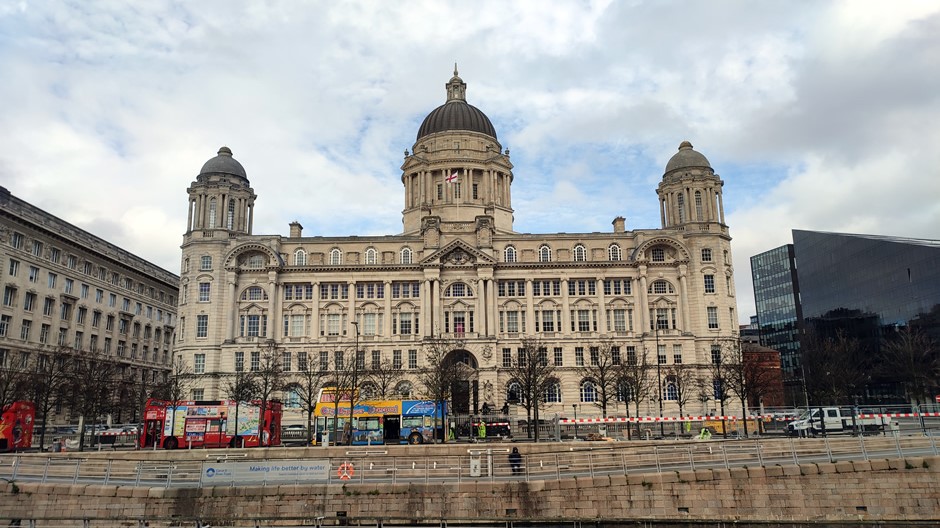
The Port of Liverpool Building is also a Grade II listed building and was originally constructed as the headquarters for the Mersey Docks and Harbour Board. It was built between 1904 and 1907 on land that had been George’s Dock before it was filled in. The building served as Mersey Docks and Harbour Board offices until the 1990’s, and today it is still used as office space.

The Mersey Ferry is a ferry service operating on the River Mersey between Liverpool and the Wirral Peninsula. The service is operated by Merseytravel and has been in operation since 1150, when Benedictine Monks ran the first ferry service from Birkenhead to Liverpool, taking people to the small fishing village of Liverpool on market days. The current fleet consists of three vessels: the Royal Iris of the Mersey, Snowdrop, and Royal Daffodil. The ferries are a popular tourist attraction and offer views of Liverpool’s waterfront. The Mersey Ferry has been featured in popular culture in various forms. For example, the song “Ferry Cross the Mersey” by Gerry and the Pacemakers is about the ferry service. The ferry has also been featured in various films and TV shows.
It may be worth mentioning here that there are also three tunnels that connect the city of Liverpool with the Wirral. These are the Mersey Railway Tunnel (opened 1886), and two road tunnels - the Queensway Tunnel (opened 1934) and the Kingsway Tunnel (opened 1971). The Queensway Tunnel runs from Liverpool city centre to Birkenhead and is often referred to as the “Birkenhead tunnel” or "old tunnel". The Kingsway tunnel opened in 1971, as traffic levels increased, and runs from Liverpool to Wallasey.

Liverpool Cruise Terminal is a 1,150 ft (350m) long floating structure situated on the River Mersey enabling large cruise ships to visit without entering the enclosed dock system or berthing mid-river and tendering passengers ashore. It is owned and operated by Liverpool City Council and has welcomed over 800 cruise ships carrying over 1 million international passengers and crew since opening in 2007. The terminal is located at Princes Parade.
Liverpool Parish Church (Our Lady and Saint Nicholas)

The Church of Our Lady and Saint Nicholas (above) is the Anglican parish church of Liverpool. The site is said to have been a place of worship since at least the 1250’s. The church is situated close to the River near the Pier Head. It is open to visitors throughout the week and at the time of writing, services are held here every day, and the church is open to visitors throughout the week.

Liverpool Town Hall is a magnificent 18th century Grade I listed building situated in the heart of the culture quarter, close to Mathew Street. It is recognised as one of the finest surviving town halls of the 18th Century. The Hall has been a civic stage for significant moments in the city, from the famous homecoming of The Beatles to the royal visit of HRH Queen Elizabeth II. It is also a popular wedding venue.

Superlambanana is (or rather was, before the time of this visit) a bright yellow sculpture in the city. It was designed by New York City-based Japanese artist Taro Chiezo. The sculpture weighs almost 8 metric tonnes (7.9 imperial tons) and stands at 17 feet (5.2m) tall. It is intended to be a cross between a banana and a lamb. Superlambanana was created in 1998 for the Art Transpennine exhibition. It is located in Tithebarn Street, outside the Anvil Robarts Library of Liverpool John Moores University, although has previously been sited on Wapping Dock, just southeast of The Royal Albert Dock. The sculpture received a makeover ahead of ahead of the Eurovision Song Contest 2023. As the song contest was held on behalf of Ukraine, winners of the 2022 contest (but unable to host it, due the Russian invasion), Liverpool City Council’s culture team commissioned a repainting of the Superlambanana in blue and yellow, the colours of the Ukrainian flag.

Municipal Buildings (above) is a former council facility on Dale Street. It is Grade II listed and opened in 1868 and in 2017, Liverpool City Council moved from here to the Cunard Building. The building has now been converted into a swanky hotel (The Municipal Hotel), opening in May 2023. The building was built by the town council to accommodate the growing number of administrative staff and was designed by John Weightman. It is well known for its pyramidal spire, which is visible throughout the city. The Dale Street building is notably constructed in the Italian and French Renaissance styles and also has 16 sandstone statues on its walls representing Liverpool’s arts, sciences and industries.

Now heading into the city centre, St Johns Beacon is a radio and observation tower in the heart of the city. It was built in 1969 and opened by Queen Elizabeth II. It was designed by James A. Roberts Associates in Birmingham. It is approximately 450 feet (138m) tall, and at the time of writing is the second tallest free-standing building in Liverpool and (the 32nd tallest in the United Kingdom. The Beacon is also home to the award winning radio stations Radio City, Radio City Talk, and Great Hits Radio. It is open all year round, 7 days a week and offers unrivalled views of Merseyside, the Wirral, North Wales and as far away as Blackpool on clear days.

The Queen Victoria Monument is a large neo-Baroque monument built over the former site of Liverpool Castle at Derby Square. It was unveiled in 1906 and designed by F. M. Simpson of the Liverpool School of Architecture. The monument features 26 bronze figures by C. J. Allen and is a landmark feature of the city. The figures on the monument include, as one might expect from the name, a prominent one of Queen Victoria.

The Bluecoat is Liverpool’s contemporary arts centre and a working home for artists. It is located in School Lane and is the oldest surviving building in central Liverpool. The Bluecoat was built in 1716-17 as a charity school and has been an active Arts Hub for the last 100 years. It has a dynamic programme of exhibitions and events, an award-winning programme for families and children, a bustling café and a garden.

Liverpool One is a shopping, residential, and leisure complex. It is a retail-led development anchored by the department store John Lewis. The project involved the redevelopment of 42 acres of land in the city centre and comprises over 170 shops, more than 500 apartments, three hotels, 25 restaurants, a 14-screen Odeon cinema, three office buildings, a Green Flag awarded five-acre public park, 2,000 car parking spaces and a public transport interchange. Understandably, it is sure to offer something for everyone (in the author’s case, an official Lego store!).
Some more general photos taken whilst visiting the city are showing in the thumbnail gallery below (click on an image to enlarge):
Slightly Further Afield
Stanley Dock Tobacco Warehouse

The Stanley Dock Tobacco Warehouse (above) is a Grade II listed building and is the world’s largest brick warehouse with a net floor area of 1.6 million square feet (148,644m²)1. It is located at the heart of Liverpool’s historic docks and has been converted into enormous warehouse homes with spectacular views over the calm waters of Stanley Dock. The building was completed in 1901 and was used to store tobacco. It has been converted into luxury waterfront apartments that bring New York-style ‘loft living’ to historic Stanley Dock. The building features exposed brickwork, cast-iron columns and concrete ceiling beams that combine with impeccable modern design to propel this iconic building into the 21st century, whilst preserving its original architectural charm.
 |
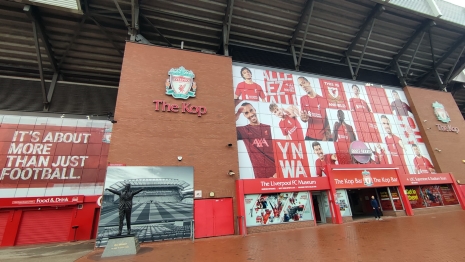 |
|
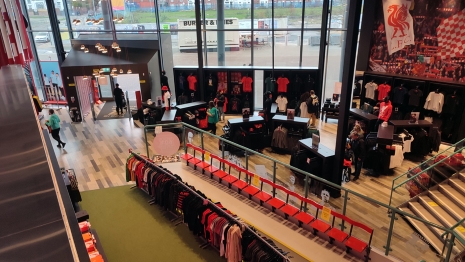 |
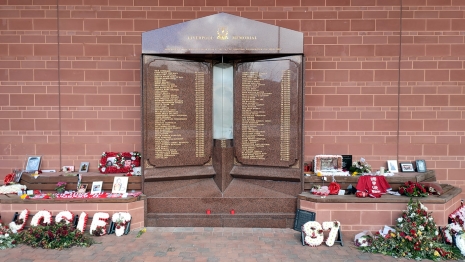 |
|
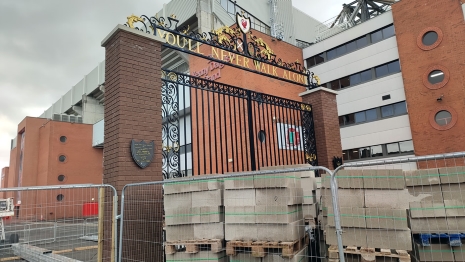 |
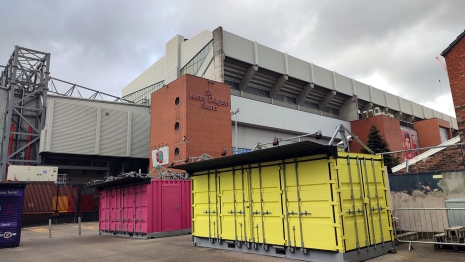 |
|
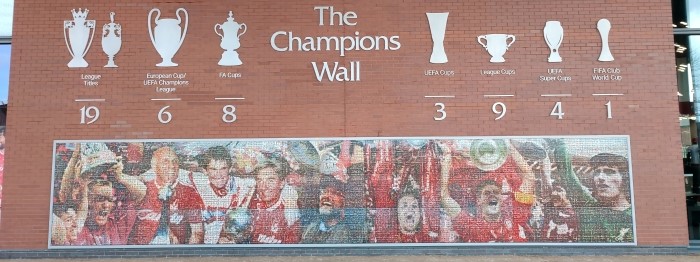 |
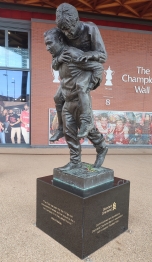 |
Anfield (above) is a famous football stadium in Anfield, Liverpool, which has a seating capacity of 53,394. It has been the home of Liverpool F.C. since their formation in 1892. The stadium is located 2.4 miles (3.9km) northeast of Liverpool City Centre. The new flagship LFC retail store at Anfield opened its doors here on Monday 14th August 2017. This new, state of the art store comprises of 19,500 square feet of selling space over two floors and also includes a café. Clearly, to go into the full history of Liverpool F.C. and Anfield is beyond the scope of this webpage. Some sights seen here included the famous Shankly Gates bearing the words “You’ll Never Walk Alone”, a variety of plaques and monuments including a 2020 statue of Bob Paisley carrying off injured Emlyn Hughes, Anfield, April 1968, and on a sombre note, a memorial to the Hillsborough Disaster of 1989.
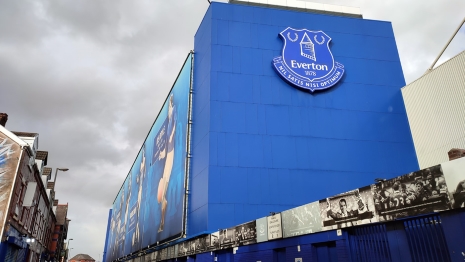 |
 |
Goodison Park (above, left) is a football stadium in the Walton area of Liverpool, 2 miles (3km) north of the city centre. It has been the home of Everton Football Club since its completion in 1892 and is one of the oldest purpose-built football stadiums in the entire world. It has a capacity of 39,414 and has hosted more top-flight games than any other stadium in England. At the time of writing, Everton Football Club will be moving from Goodison Park to a new £500m stadium at Bramley-Moore Dock (shown under construction above, right). The new stadium is a bowl design constructed of steel and glass and expected to have a capacity of 52,888. The move is expected to take place in the summer of 2024.

Aintree Racecourse is located in the Metropolitan Borough of Sefton, Merseyside, bordering the city of Liverpool. It is the venue for the United Kingdom’s annual Grand National steeplechase, a National Hunt horse race which takes place in April over three days. The racecourse also holds race meetings at other times throughout the year. The course is 4 miles (6.4km) long and has 16 fences. Within the Aintree racecourse is Aintree Motor Racing Circuit, a 3 mile (4.8km) motor racing circuit which staged the British Grand Prix in 1955, 1957, 1959, 1961, and 1962. Other events held here in the past have included music concerts (including Michael Jackson in 1988), and the racecourse also contains a 9-hole golf course and driving range within its boundaries. The racecourse is conveniently located on the A59, just one mile from the M57 and M58 motorways, which link the M62 and M62 motorways. The nearest mainline station is Liverpool Lime Street and Aintree railway station itself is located on the Ormskirk branch of the Merseyrail network’s Northern Line.

The house where Ken Dodd lived (above) is located in Knotty Ash, Liverpool (Ken Dodd was mentioned earlier, under the section Liverpool Lime Street Station). The house on Thomas Lane was built in 1782 and was passed down his family for generations. The house on the left-hand side is the original whilst the house on the right was converted from a barn. It was here that his family’s coal business was based. The house is famous because it was the home of the late Ken Dodd who made Knotty Ash world famous with stories of his Diddymen and their jam butty mines.
Brookside Close in Liverpool was a fictional street that was used as the setting for the popular soap opera Brookside, which aired on Channel 4 from 1982 to 2003. The street consisted of 13 houses, which were built in 1982 by a local developer and rented out to the production company. The houses were located in West Derby, a suburb of Liverpool, and were surrounded by a high wall and security gates to protect them from vandalism and curious fans.
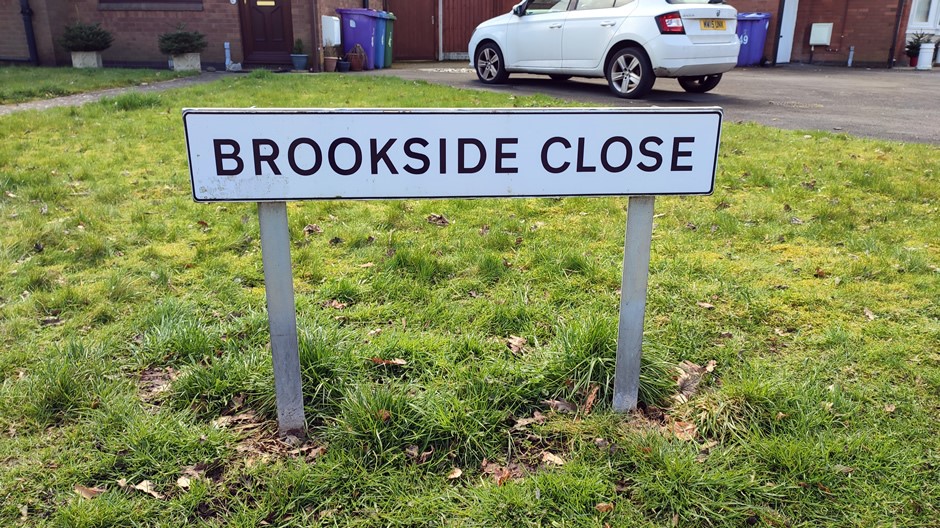
The show was known for its realistic and gritty portrayal of working-class life in Liverpool, and tackled many controversial and social issues, such as domestic violence, drug addiction, incest, rape, murder, and terrorism. The show also featured some memorable characters and storylines, such as the feud between the Grant and Dixon families, the lesbian kiss between Beth Jordache and Margaret Clemence, the body under the patio of Trevor Jordache, and the siege of Brookside Close by armed gunmen.
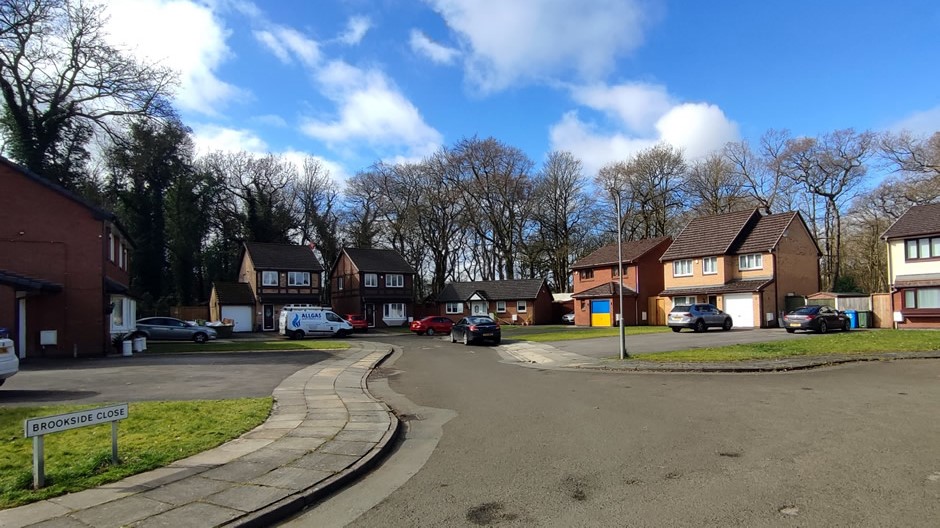
The show ended in 2003 after a decline in ratings and a change in direction by Channel 4. The houses were sold off to private owners, who renovated them and removed any traces of their soap opera past. Some of the houses have been sold again since then, fetching prices of up to £250,000. Brookside Close remains a part of Liverpool's cultural history and a landmark for fans of the show.

Above: Skyline of Liverpool as seen from Everton Park and Garden
[Photos: March 2023, Text: May 2023]
References and Further Information
1. In Situ Information Boards and Literature.
2. Collard, I. (2017) Liverpool City Centre History Tour.
Gloucestershire, UK: Amberley Publishing.
3. Liverpool (2020). London: Rough Guides.
4. Liverpool (2023) Wikipedia. Available at:
https://en.wikipedia.org/wiki/Liverpool (Accessed: May 2023).
5. Liverpool Echo: Latest Liverpool and Merseyside News, sports and
what’s on (no date) liverpoolecho. Available at:
https://www.liverpoolecho.co.uk/ (Accessed: May 2023).
6. Liverpool - pop city: map guide of What to see, How to get there
(2016). City Quickmaps.
Back to Top
